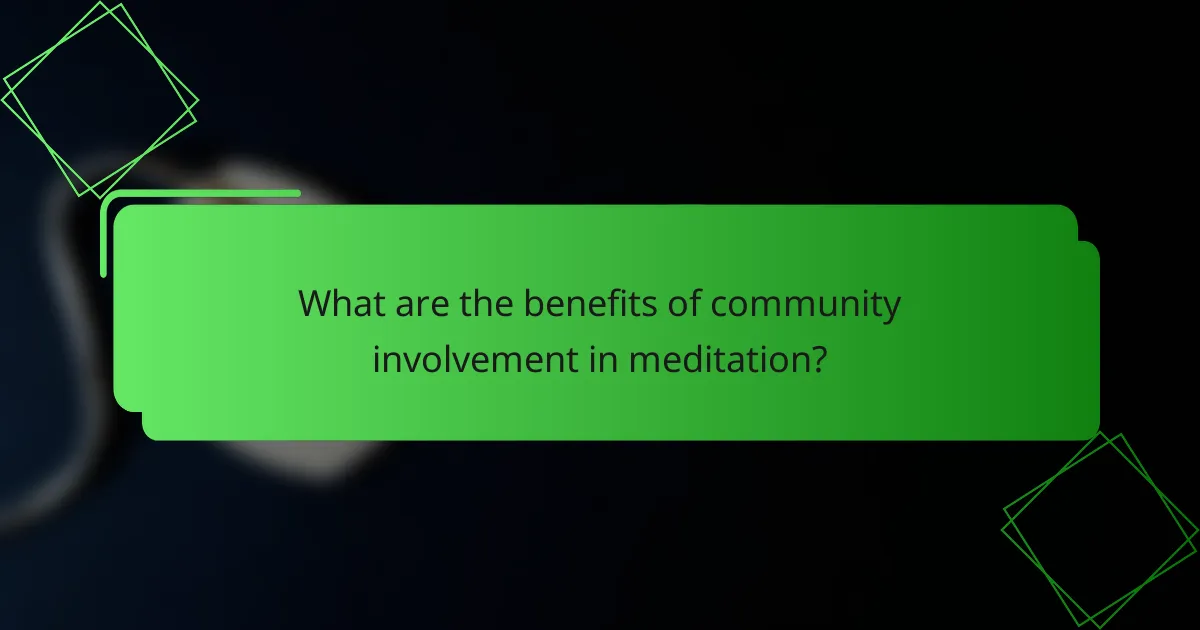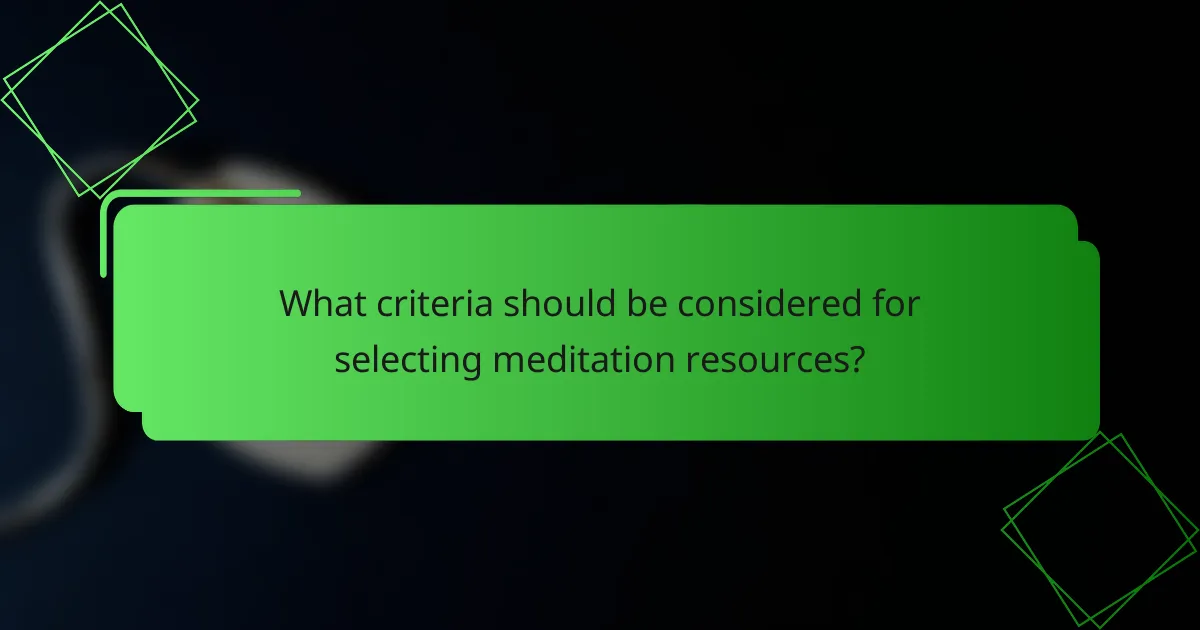Communities play a vital role in enhancing accessible meditation practices by creating inclusive environments that welcome diverse participants. Through local groups, online platforms, and supportive networks, individuals can find resources and encouragement to engage in meditation. Additionally, digital tools like apps and podcasts further broaden access, ensuring that meditation is available to everyone, regardless of their background or needs.

How can communities enhance accessible meditation practices?
Communities can enhance accessible meditation practices by fostering inclusive environments that support diverse participants. This can be achieved through various initiatives, such as forming local meditation groups, utilizing online platforms, organizing workshops, and creating peer support networks.
Community-led meditation groups
Community-led meditation groups provide a space for individuals to practice together, often in local settings like parks or community centers. These groups can be tailored to different skill levels and backgrounds, making meditation more approachable for everyone.
To start a community-led group, gather interested individuals and choose a regular meeting time. Consider incorporating various meditation styles, such as mindfulness or loving-kindness, to cater to different preferences.
Online meditation platforms
Online meditation platforms offer accessible resources for individuals unable to attend in-person sessions. These platforms typically provide guided meditations, courses, and community forums, allowing users to connect and share experiences.
Look for platforms that offer free or low-cost options, as well as a range of meditation styles. Popular platforms may include apps or websites that allow users to filter content based on duration, focus, or experience level.
Local workshops and events
Local workshops and events can introduce meditation practices to a wider audience and provide hands-on guidance. These events often feature experienced instructors who can offer personalized tips and address specific challenges faced by participants.
Consider collaborating with local wellness centers or yoga studios to host workshops. Offering sliding scale fees or free sessions can further enhance accessibility for those with financial constraints.
Peer support networks
Peer support networks create a sense of community among individuals practicing meditation. These networks can facilitate accountability, encouragement, and shared learning experiences, making meditation more sustainable for participants.
To establish a peer support network, encourage members to meet regularly to discuss their meditation journeys. Utilize social media or messaging apps to maintain communication and share resources, fostering a supportive environment.

What digital products support accessible meditation?
Digital products that enhance accessible meditation include apps, podcasts, and virtual reality experiences. These tools cater to various preferences and accessibility needs, making meditation more inclusive for everyone.
Meditation apps like Headspace
Meditation apps, such as Headspace, provide structured programs that guide users through various meditation techniques. They often include features like customizable session lengths, themed meditations, and progress tracking, which can help users stay engaged and motivated.
When choosing a meditation app, consider factors like user interface, available content, and subscription costs. Many apps offer free trials, allowing users to explore features before committing to a paid plan.
Guided meditation podcasts
Guided meditation podcasts are an excellent resource for those who prefer auditory guidance. These podcasts typically feature experienced instructors leading listeners through meditation sessions, often focusing on specific themes such as stress relief or mindfulness.
To find suitable podcasts, search popular platforms like Spotify or Apple Podcasts, where you can explore ratings and reviews. Look for episodes that fit your schedule, as many podcasts offer sessions ranging from a few minutes to over an hour.
Virtual reality meditation experiences
Virtual reality (VR) meditation experiences immerse users in calming environments, enhancing the meditation process. These experiences often include scenic visuals and soothing sounds, creating a more engaging atmosphere that can help deepen relaxation.
Consider the hardware requirements for VR meditation, as it typically requires a compatible headset. Many VR platforms offer a variety of meditation experiences, so explore options that align with your preferences and budget.

What are the benefits of community involvement in meditation?
Community involvement in meditation enhances the practice by fostering a sense of belonging, increasing motivation, and providing essential support. Engaging with others can lead to deeper commitment and shared insights, making meditation more accessible and enriching for everyone involved.
Increased motivation and accountability
Being part of a meditation community can significantly boost motivation and accountability. When individuals commit to a group, they are more likely to stick to their meditation routines, knowing others are counting on them. Regular group sessions can create a structured environment that encourages consistent practice.
For example, setting a weekly meditation schedule with a group can help participants maintain their practice, as they are less likely to skip sessions when they know others are participating. This shared commitment can lead to improved meditation habits over time.
Shared resources and knowledge
Communities often provide access to a wealth of resources and knowledge that can enhance meditation practices. Members can share techniques, recommended readings, and useful apps, making it easier for everyone to find what works best for them. This collaborative approach can introduce new perspectives and methods that individuals may not have explored on their own.
For instance, a local meditation group might host workshops or invite experienced practitioners to share their insights. This exchange of information can help participants deepen their understanding and improve their meditation skills.
Enhanced emotional support
Emotional support is a crucial benefit of community involvement in meditation. Sharing experiences and challenges with others can create a safe space for individuals to express their feelings and receive encouragement. This support can be particularly valuable during difficult times when personal meditation practices may falter.
In a community setting, members can offer empathy and understanding, helping each other navigate the ups and downs of their meditation journeys. Regular check-ins or sharing circles can foster deeper connections and reinforce the sense of belonging that is vital for emotional well-being.

How do cultural factors influence meditation accessibility?
Cultural factors significantly shape meditation accessibility by affecting the styles practiced, the resources available, and the community engagement in different regions. These influences can create barriers or enhance the experience, depending on how inclusive and adaptable the practices are to diverse populations.
Diverse meditation styles
Diverse meditation styles reflect cultural backgrounds and beliefs, which can either facilitate or hinder accessibility. For example, mindfulness meditation is popular in Western cultures, while practices like Zen or Transcendental meditation may be more prevalent in Eastern traditions. Understanding these styles helps communities tailor offerings that resonate with their members.
Communities can benefit from introducing various meditation practices that align with local traditions, such as incorporating elements from indigenous practices or community rituals. This approach not only makes meditation more relatable but also fosters a sense of belonging among participants.
Language inclusivity in resources
Language inclusivity is crucial for making meditation resources accessible to a broader audience. Providing materials in multiple languages ensures that non-native speakers can fully engage with the content. This can include translated guided meditations, written instructions, and community workshops.
Communities should prioritize creating bilingual or multilingual resources, especially in areas with diverse populations. Utilizing local dialects or culturally relevant terminology can enhance understanding and encourage participation among various groups.
Community-specific practices
Community-specific practices can enhance meditation accessibility by integrating local customs and values into the meditation experience. For instance, incorporating local music, art, or storytelling can make sessions more engaging and relevant to participants. This approach fosters a deeper connection to the practice.
Engaging community leaders or influencers in the meditation process can also help promote acceptance and participation. By aligning meditation practices with community events or cultural celebrations, organizations can create a more inviting atmosphere for newcomers.

What criteria should be considered for selecting meditation resources?
When selecting meditation resources, consider accessibility features, community feedback, and cost structures. These criteria help ensure that the resources meet diverse needs and preferences, making meditation practices more inclusive and effective.
Accessibility features
Accessibility features are essential for ensuring that meditation resources cater to individuals with varying abilities. Look for options that provide audio descriptions, closed captioning, and adjustable playback speeds. Resources that offer visual aids or alternative formats can also enhance the experience for those with sensory impairments.
Additionally, consider platforms that are compatible with assistive technologies, such as screen readers or voice commands. This compatibility can significantly improve the usability of meditation apps and websites for individuals with disabilities.
Community feedback and reviews
Community feedback is a valuable resource when evaluating meditation tools. Look for platforms that allow users to leave reviews and ratings, as these can provide insights into the effectiveness and user-friendliness of the resources. Pay attention to comments regarding the inclusivity of the content and the overall user experience.
Engaging with community forums or social media groups dedicated to meditation can also help you gather opinions and recommendations. This peer feedback can guide you towards resources that have been positively received by others with similar needs.
Cost and subscription models
Cost is a significant factor when selecting meditation resources, as many options vary widely in price. Some platforms offer free content, while others may require a subscription or one-time purchase. Assess whether the cost aligns with your budget and if the resource provides value for the investment.
Consider subscription models that offer flexible payment options, such as monthly or annual plans. Some platforms may provide trial periods, allowing you to explore their offerings before committing financially. This approach can help you find resources that fit your needs without overspending.


